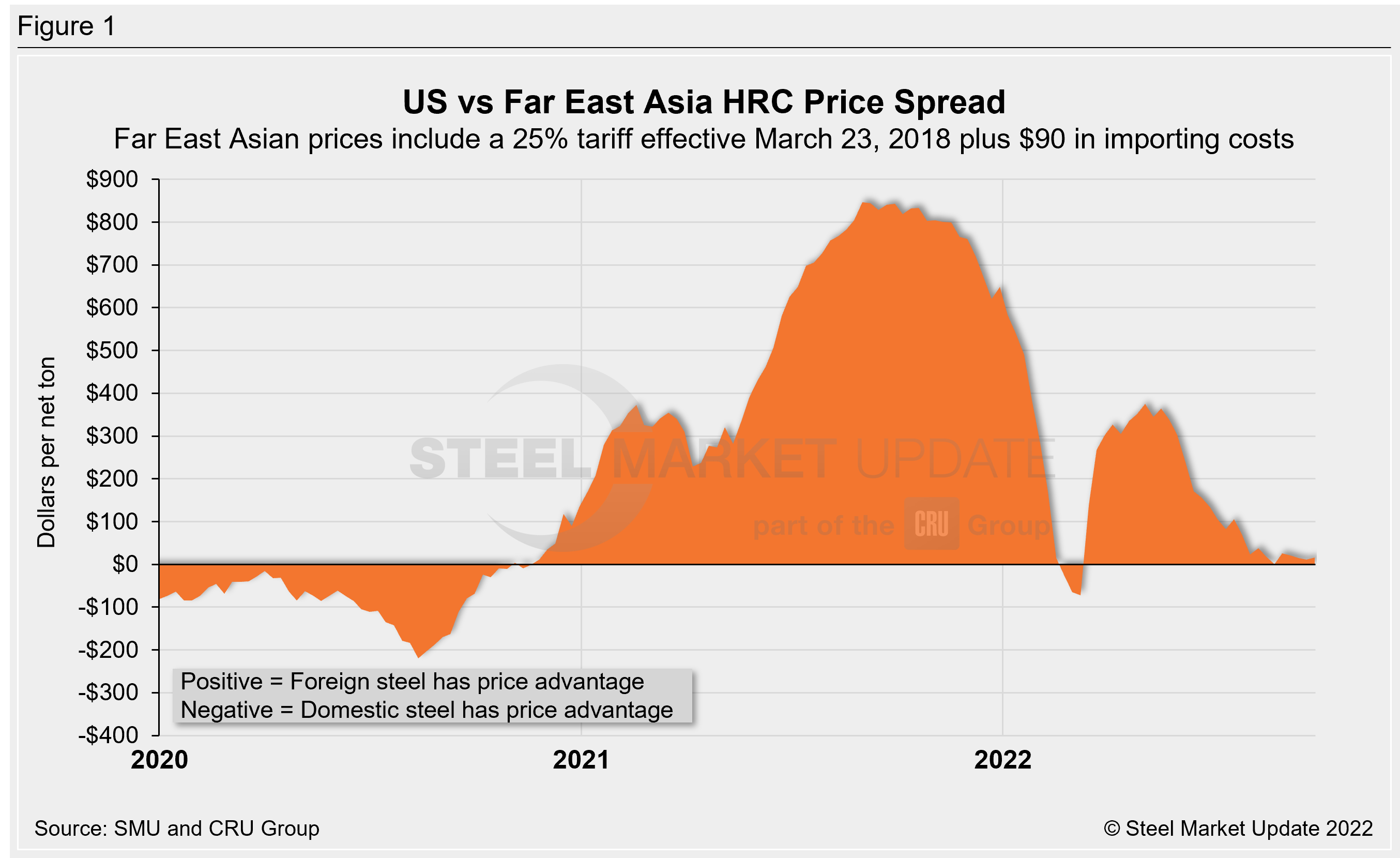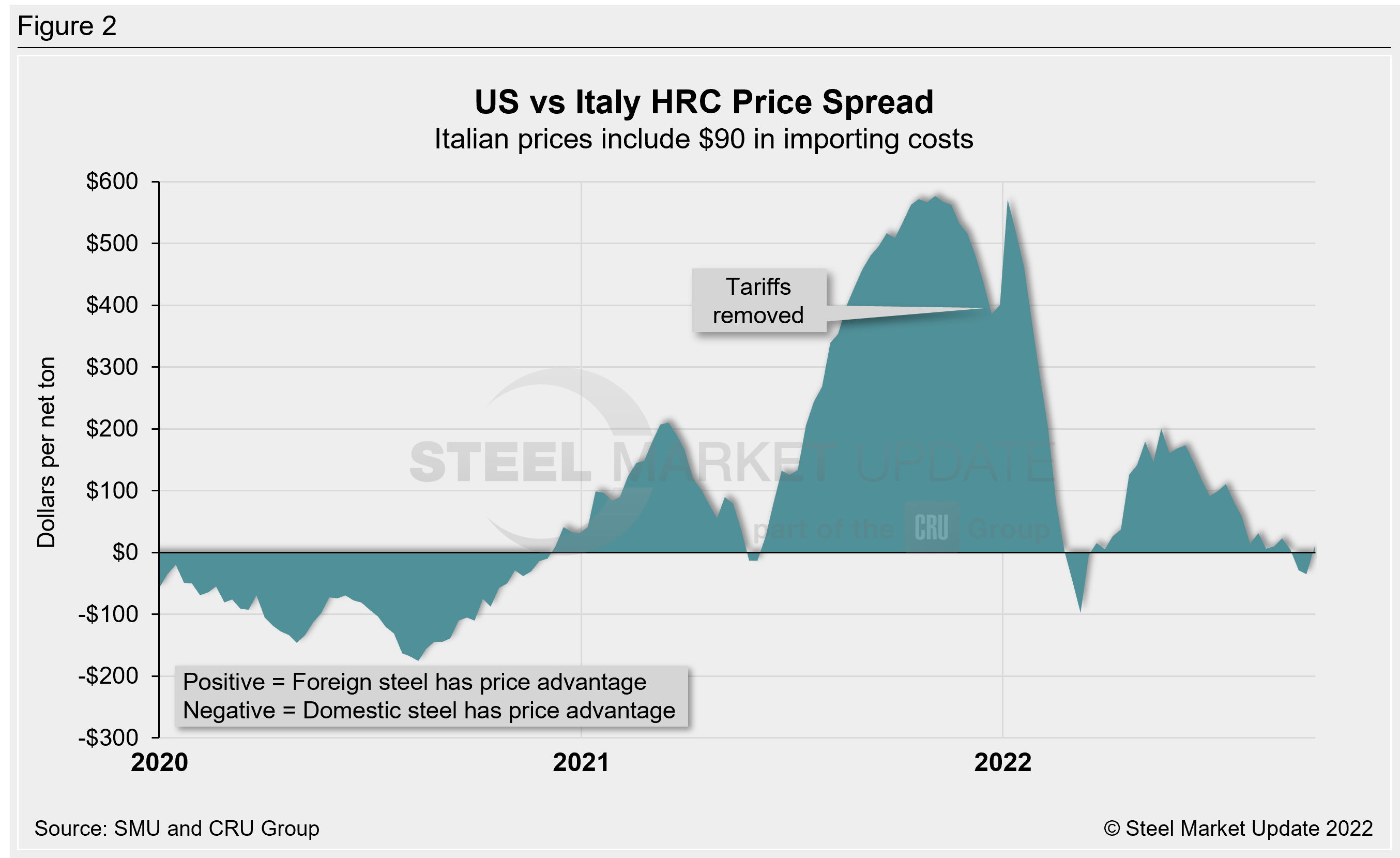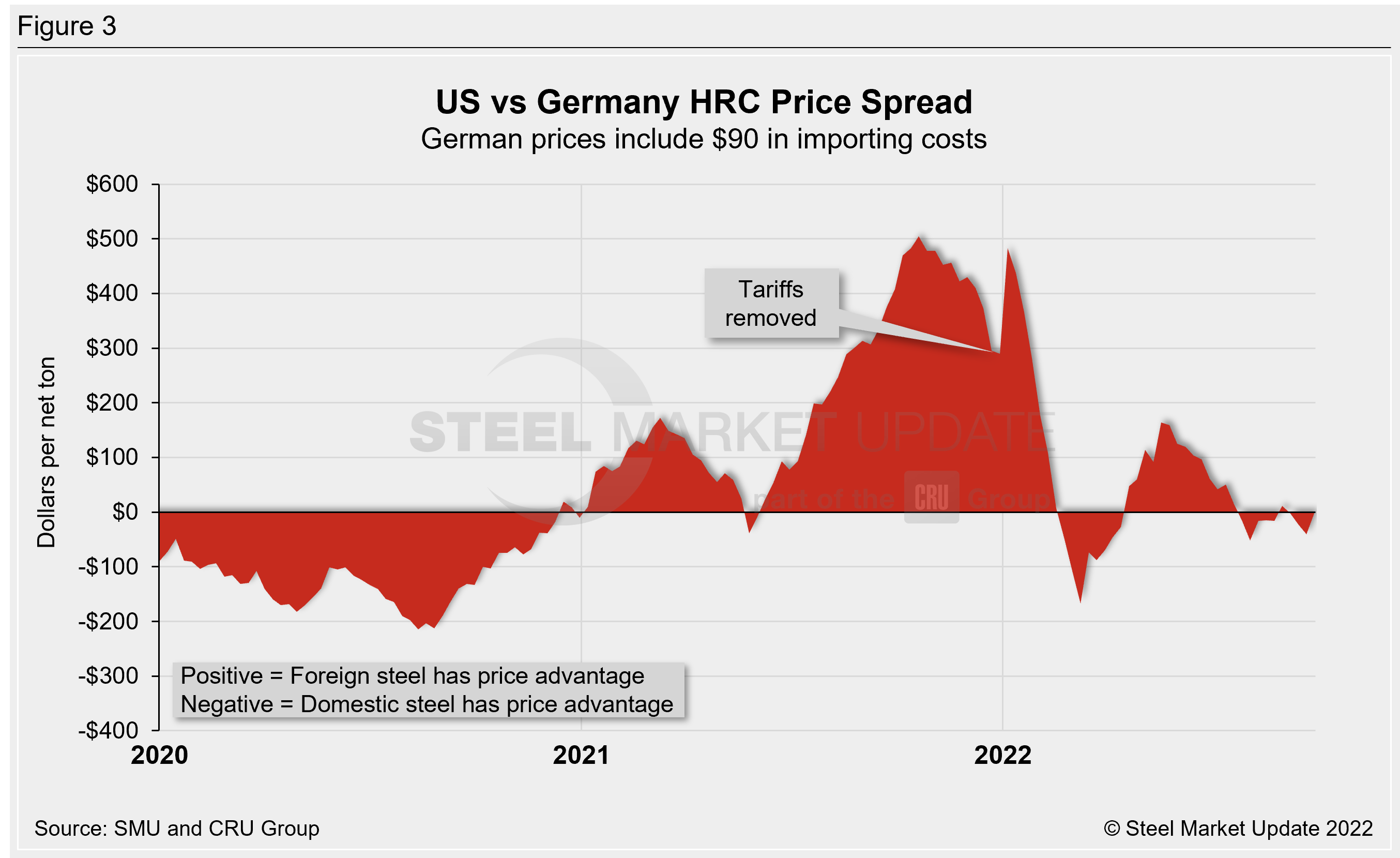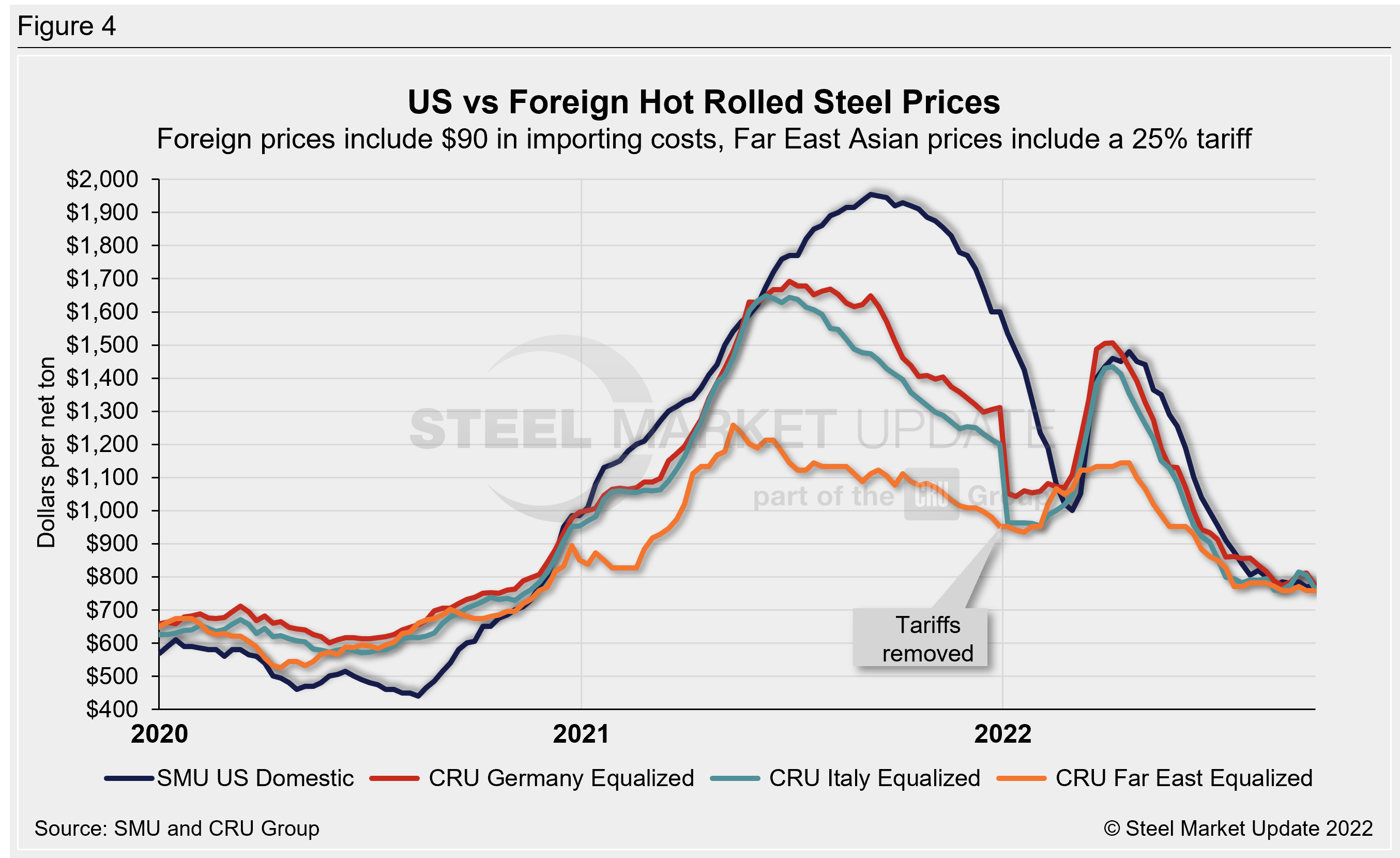International Steel Prices

Foreign HRC Competitiveness Remains Minimal
Written by Brett Linton
September 29, 2022
The appeal to import foreign hot-rolled coil (HRC) in place of purchasing domestic steel remains low to non-existent, but that may be changing, according to our latest foreign versus domestic price analysis. Foreign prices were flat to down as much as $40 per net ton this week, while domestic prices increased $5 per ton. Foreign HRC prices are now theoretically 0–2% cheaper than domestic steel. Prior to this week, US HRC prices were as much as 5% cheaper than imported steel in two regions. The potential discount on imported products began to narrow back in May and did so through September.
![]() The following calculation is used by SMU to identify the theoretical spread between foreign HRC prices (delivered to US ports) and domestic HRC prices (FOB domestic mills). Our analysis compares the SMU US HRC weekly index to the CRU HRC weekly indices for Germany, Italy, and Far East Asian ports. This is only a theoretical calculation as costs to import can vary greatly and often fluctuate, ultimately influencing the true market spread.
The following calculation is used by SMU to identify the theoretical spread between foreign HRC prices (delivered to US ports) and domestic HRC prices (FOB domestic mills). Our analysis compares the SMU US HRC weekly index to the CRU HRC weekly indices for Germany, Italy, and Far East Asian ports. This is only a theoretical calculation as costs to import can vary greatly and often fluctuate, ultimately influencing the true market spread.
In consideration of freight costs, handling, and trader margin, we add $90 per ton to all foreign prices to provide an approximate “CIF US ports price” that can be compared against the SMU domestic HRC price. Buyers should use our $90 per ton figure as a benchmark, adjusting it as necessary based on their own shipping and handling costs. If any of our readers have experience importing foreign steel and want to share your thoughts on these costs, we welcome your insight and comments: Brett@SteelMarketUpdate.com.
Note that effective Jan. 1, 2022, the traditional Section 232 tariff no longer applies to most imports from the European Union. It has been replaced by a tariff rate quota (TRQ). Therefore, the German and Italian price comparisons in this analysis no longer include a 25% tariff. SMU still includes the 25% S232 tariff on foreign prices from other countries. We do not include any antidumping (AD) or countervailing duties (CVD) in this analysis.
Far East Asian HRC (East and Southeast Ports)
As of Wednesday, Sept. 28, the CRU Far East Asian HRC price remained unchanged week-over-week at $535 per net ton ($590 per metric ton), also unchanged compared to one month prior. Adding a 25% tariff and $90 per ton in estimated import costs, the delivered price of Far East Asian HRC to the US is $759 per ton. The latest SMU hot-rolled average is $775 per ton, up $5 week-over-week, but down $10 compared to one month ago. Therefore, US-produced HRC is now $16 per ton more expensive than steel imported from Far East Asia, up from a spread of $11 last week, but down from $26 four weeks prior. Recall that five weeks ago, we saw identical prices between these regions, an occurrence not seen in steel since early March 2022. This differential has eased since, peaking at $375 per ton in May. The largest price spread between these regions was $847 per ton in September 2021, when Far East Asian prices held a considerable advantage.

Italian HRC
CRU published Italian HRC prices at $675 per net ton ($745 per metric ton), down $40 per ton from last week, but up $3 per ton compared to one month ago. After adding import costs, the delivered price of Italian HRC is approximately $765 per ton. Accordingly, domestic HRC is now theoretically $10 per ton more expensive than imported Italian HRC. In the two weeks prior to this, we saw the opposite situation when domestic prices held a $29–35 per ton advantage over Italian HRC. One month ago the theoretical foreign discount was $23 per ton. The highest spread this year was $200 per ton in May. Before the removal of the 25% Section 232 tariff, the November 2021 spread of $577 per ton was the largest in SMU’s data history.

German HRC
The latest CRU German HRC price decreased $36 per ton from last week to $685 per net ton ($755 per metric ton), up $1 per ton from one month ago. After adding import costs, the delivered price of German HRC is approximately $775 per ton. Accordingly, domestic HRC is now theoretically the same cost as imported German HRC. Prior to this week, domestic HRC had held the price advantage for all but one week since late July. German HRC held the price advantage for the three months prior to that, having reached a 2022 high of $164 per ton in May. Prior to the removal of the 25% tariff, the October 2021 spread of $504 per ton was the widest in SMU’s data history.

The graph below compares all four price indices and highlights the effective date of the tariffs. Foreign prices are referred to as “equalized,” meaning they have been adjusted to include importing costs (and tariffs in some cases) for a like-for-like comparison against the US price.

Note: Freight is an important part of the final determination on whether to import foreign steel or buy from a domestic mill supplier. Domestic prices are referenced as FOB the producing mill, while foreign prices are CIF the Port (Houston, NOLA, Savannah, Los Angeles, Camden, etc.). Inland freight, from either a domestic mill or from the port, can dramatically impact the competitiveness of both domestic and foreign steel. When considering lead times, a buyer must take into consideration the momentum of pricing both domestically and in the world markets. In most circumstances (but not all), domestic steel will deliver faster than foreign steel ordered on the same day.
By Brett Linton, Brett@SteelMarkeUpdate.com

Brett Linton
Read more from Brett LintonLatest in International Steel Prices

US and offshore HRC prices tick lower
The threat of tariffs over the past two months has been a springboard for US prices. But the Section 232 reinstatement on March 13 narrowed the domestic premium over imports on a landed basis.

Domestic CRC prices surge ahead of imports
The price spread between stateside-produced CR and imports reached its widest margin in over a year.

US HR prices rising faster than offshore tags
Hot-rolled (HR) coil prices continued to rally in the US this week, quickly outpacing price gains seen abroad. The result: US hot band prices have grown widely more expensive than imports on a landed basis. The premium US HR tags carry over HR prices abroad now stands at a 14-month high. SMU’s average domestic HR […]

US HR price premium over imports widens
Hot-rolled (HR) coil prices were flat in the US this week, while tags in offshore markets were mostly down.

US HR price premium over imports edges up
The price premium between stateside hot band and landed imports widened slightly this week.
